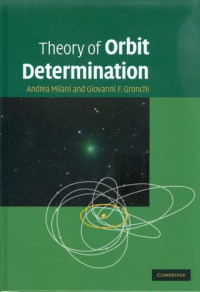
Textbook
Theory of orbit determination
"Determining orbits for natural and artificial celestial bodies is an essential step in the exploration and understanding of the Solar System. However, recent progress in the quality and quantity of data from astronomical observations and spacecraft tracking has generated orbit determination problems which cannot be handled by classical algorithms. This book presents new algorithms capable of handling the millions of bodies which could be observed by next generation surveys, and which can fully exploit tracking data with state-of-the-art levels of accuracy. After a general mathematical background and summary of classical algorithms, the new algorithms are introduced using the latest mathematical tools and results, to which the authors have personally contributed. Case studies based on actual astronomical surveys and space missions are provided, with applications of these new methods. Intended for graduate students and researchers in applied mathematics, physics, astronomy and aerospace engineering, this book is also of interest to non-professional astronomers"--Provided by publisher.
"This book is a tool for our own teaching and an opportunity to rethink and reorganize the results of our own research. However, I think such a book can be useful to others, for two main reasons. First, spaceflight is no longer the privilege of the few superpowers, but is becoming available to many nations and agencies. Orbit determination is an essential knowhow, both in the planning phase of mission analysis and in the operations of space missions. Thus its mathematical tools need to become widely available"--Provided by publisher.
Contents -- Preface -- Part I. Problem Statement and Requirements -- 1. The problem of orbit determination -- 2. Dynamical systems -- 3. Error models -- 4. The N-body problem -- Part II. Basic Theory -- 5. Least squares -- 6. Rank deficiency -- Part III. Population Orbit Determination -- 7. The identification problem -- 8. Linkage -- 9. Methods by Laplace and Gauss -- 10. Weakly determined orbits -- 11. Surveys -- 12. Impact monitoring -- Part IV. Collaborative Orbit Determination -- 13. The gravity of a planet -- 14. Non-gravitational perturbations -- 15. Multi arc strategy -- 16. Satellite gravimetry -- 17. Orbiters around other planets -- References -- Index.
สภานภาพ
| รหัสบาร์โค้ด | เลขหมู่ | สถานที่จัดเก็บ | สภานภาพ |
| TB001100 | QB355 M637T 2010 | NARIT Library | พร้อมให้บริการ - AVAILABLE |
รายละเอียด
| ชื่อชุด |
-
|
|---|---|
| เลขหมู่ |
QB355 M637T 2010
|
| ผู้จัดทำ | Cambridge University : New York., 2010 |
| ลักษณะวัสดุ |
x, 382 p. : ill. ; 26 cm.
|
| ภาษา |
English
|
| ISBN/ISSN |
9780521873895
|
| หมวดหมู่ |
NONE
|
| ครั้งที่จัดทำ |
1 st ed
|
|---|---|
| หัวเรื่อง | |
| ชื่อเรื่องเพิ่ม |
-
|
| การแจ้งความรับผิดชอบ |
-
|

